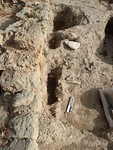| Collection: | Corinth | |
| Type: | Basket | |
| Name: | Temple E, Southeast, context 621 | |
| Area: | Temple E, Southeast | |
| Title: | Fill burial west side Room 6 | |
| Category: | Deposit | |
| Notebook: | 1109 | |
| Context: | 621 | |
| Date: | 24 4 2015 to 28 4 2015 | |
| Stratum: | 30% Medium subrounded spherical pebbles. Bones and shards scattered but in general not a main component of the soil itself. | |
| Description: | Top slope of the context is steep down to the E. The soil color is light yellowish brown. The soil compaction is firm. The soil is poorly sorted. It is silt. | |
| Notes: | Excavated by Emilio Rodriguez-Alvarez. 24-04-2015 8.00: After cleaning the the surface and record plan excavation started in this context, a fill of what seems to be a burial parallel to W wall (structure 58). The clearest boundary is with the stones of the wall, so excavation will take place W to E, starting in the SW corner, since the visible long bones seem to indicate that the head (if preserved) would be on the north side of the context. 9.40: Apart from the long bone already visible on surface two more appeared c.2cm below. The disposition of these bones, however, does not follow any apparent order, and the stacking they form made necessary to change the direction of excavation from W-E to S-N. This work continued all morning, but the context could not be finished. It was covered with plastic to protect it from the rain during the weekend. 27-04-2015 7.47: Plastic cover removed and excavation resumed. Weekend was dry and not excessively hot; bones not affected apparently by exposure and no traces of condensation under the plastic. Excavation was resumed with wooden tools and brushes only in a N-S direction, following the clearest edge of the deposit. 8.58: Context was levelled leaving exposed fragments of long bone and a pelvis (?), but no traces of articulation are found. In the north edge of the context traces of what appears to be a fragment of skull are spotted under a disorganised pile of small rocks (not a defined burial lining). These will be removed before continuing with excavation. 10.49: After cleaning the context a picture of the disarticulated bones was taken. From now on they will be extracted whenever this is possible. Since there is no change on the soil around these bones the aim now is keep excavating until the context is exhausted. 28-04-2015 7.40: Work resumed in the context. Excavation took place S-N to avoid removing the stones accumulated in the N edge before necessary. 8.50: The context is considered to be closed after discussing its interpretation with the field director. During the excavation I detected a change in the humidity of the soil that I first adscribed to the early hours of the day. I checked with the 4 edges of the deposit and #621 was still cutting the yellow compact soil on the north, east and south, and a yellower less compact soil associated to the wall (structure 58). To the west, however, after scratching with wooden sticks once more, the surface of the context I started to loose these edges. My interpretation was that #621 has a very diffuse transition with the context below, and that this is, suppossely, the one below the yellow compact layer in which the burials are excavated. This yellow layer is very distinctive, and there is no doubt it was absent from the bottom of #621. When this was excavated in the middle ages they cut through the bottom of the yellow soil and reached the layer below. The boundary is very diffuse at the bottom and could be considered it was missed at a higher elevation. However, the fact that the layer was excavated only with the wooden sticks and the way the edges are defined in both sides allows me to consider that this loss, if it took place, did not account for more than 5mm. Special care was taken to observe the finds of the soil extracted after the edges were checked, and it resulted sterile. The soil was collected and sieved apart from the current context, with the same result of absence of finds. Preeliminary interpretation of the context is that this was cut along the wall after #1996-1. If it was intended to be a burial or not will require a careful study of the material discovered. But the presence of animal bones in the deposit (fish vertebrae, mandible of an ovicaprid (?)) and the piling of this with the ceramic material recovered (very fragmented) seem to indicate that, if ever tool place, the burial was heavily disturbed. | |
| Context Pottery: | Fineware. preMedieval4 bodysherds. ; Fineware. plain glazed, bowl. 3 rims. 7 bodysherds. ; Fineware. slip and glaze painted, dish. 1 rim. ; Coarseware. painted stamnos, stamnos. 1 handle. ; Fineware. glazed painted IV, bowl. 3 bodysherds. ; Fineware. slipped plain glazed (1100-1300), lamp. 1 rim. ; Fineware. | |
| Pottery Summary: | 20 frag(s) 0.09 kg. (0% saved) fineware. | |
| 139 frag(s) 1.5 kg. (0% saved) coarseware. | ||
| 38 frag(s) 0.1 kg. (0% saved) cooking ware. | ||
| Period: | Frankish (1210-1458 AD) | |
| Grid: | 118.5-118.2E, 1078.5-1079.4N | |
| XMin: | 118.2 | |
| XMax: | 118.5 | |
| YMin: | 1078.5 | |
| YMax: | 1079.4 | |
| Site: | Corinth | |
| City: | Ancient Corinth | |
| Country: | Greece | |
| Masl: | 84.861-85.13m. | |
| References: | Images (7) |
|


